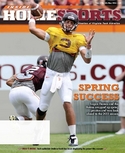The compliance corner answers questions concerning the governance of intercollegiate athletics and its impact on our athletics department. Have a question? Please send it to inside@hokiesports.com and we’ll answer it in upcoming issues.
Now, here are a couple of questions that we’ve received from Tech alums and fans over the past few months, with responses from Tim Parker, senior assistant AD for compliance:
Q: Just wondering if you’ve been following this Perry Jones case at Baylor. Perry got suspended because his mom borrowed money from his AAU coach when she was having health issues. She’s already paid the money back – and the kid was a sophomore in HIGH SCHOOL. He wasn’t an NCAA athlete yet, and he didn’t know about the loans. Can you explain the NCAA’s logic? Thanks. Gary in Colorado.
TP: “Let’s go back to the beginning. Perry Jones is a basketball player at Baylor – and a very good one. His mother received three 15-day loans from her son’s AAU coach, while her son was in high school. She paid those loans back in a timely manner. Her son knew nothing of the loans.
“But what often fails to get reported is that Perry Jones received a trip to San Diego for a preseason NFL game in August before he arrived at Baylor. Jones’ AAU coach paid for that trip as well.
“In all, Jones and his family received $4,100 in benefits. This violates the NCAA’s amateurism rule (Bylaw 12.1.1.1.4.3) and for this, Jones received a six-game suspension.
“Now some have compared this case with the case of Auburn quarterback Cam Newton, who was allowed to play in the national championship game after telling NCAA investigators that he knew nothing of his father’s demands for money in return for Cam’s services. However, there was no evidence of benefits received by Cam or his family. In the Jones case, benefits were clearly provided.”
Q: I’ve heard from sources inside the athletics department that recruiting services are your favorite topic these days. What is the NCAA legislation concerning recruiting services and does Virginia Tech use these services? Thanks. Marc in Philadelphia.
TP: “Your sources are good, except they left out the word ‘least’ in front of the word ‘favorite.’ Seriously though, the current issues/discussions stem from an amendment that we (the NCAA membership) voted to adopt last year. The problem originated when bogus ‘recruiting services’ began to spring up across the nation, targeted at college basketball coaches. The information provided by these bogus ‘recruiting services’ was minimal at best, and the services were very expensive, but since they were produced by individuals who controlled access to top prospects (e.g. AAU coaches), many college coaches felt compelled to purchase them.
“In response to this, an NCAA committee drafted a legislative amendment that defined a ‘recruiting service’ and listed several requirements that a service must meet in order for an intercollegiate athletics department to subscribe to it. The original amendment was directed solely at the sport of basketball, and if we had kept it that way, this issue would not currently be my least favorite. However, in an effort to maintain consistency in the area of recruiting, the proposed amendment was modified to include recruiting services in all sports. Combine that expansion with the fact that the effects of the actual wording of the amendment (now new bylaw) were not considered carefully enough, and we find ourselves – coaches and compliance staff members – wrestling with numerous unintended consequences.
“Recruiting services are used by every school in some capacity, and Virginia Tech is no different. A legitimate recruiting service saves time and money, keeps coaches from traveling more than they already do, and saves them a lot of hours compiling tape. It also helps coaches because it gives them a more comprehensive list of prospects from around the country. The new bylaw allows colleges to subscribe to a recruiting service involving prospective athletes, provided the service is made available to the public at the same rate as coaches and the information provides individual analysis of players beyond demographic information or rankings. Also, if the recruiting service offers video, it must be restricted to regularly scheduled high school, prep school or two-year college events.”




